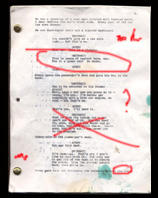Works For Me
 This being the end of the year I thought instead of a recap (who knows, I might do that later) I would offer up a little wisdom I learned while tackling a rewrite of Where Are You Seventeen? This was the first screenplay I wrote years ago and I thought I would try to update it and breath some new life into it. I also took a writing workshop this year and these are some of the things I learned from watching myself and others read their work to other writers. This is kind of a simple screenplay workflow that might save me and maybe you some headache in the future so here goes. This is by no means an absolute way to do it, just works for me:
This being the end of the year I thought instead of a recap (who knows, I might do that later) I would offer up a little wisdom I learned while tackling a rewrite of Where Are You Seventeen? This was the first screenplay I wrote years ago and I thought I would try to update it and breath some new life into it. I also took a writing workshop this year and these are some of the things I learned from watching myself and others read their work to other writers. This is kind of a simple screenplay workflow that might save me and maybe you some headache in the future so here goes. This is by no means an absolute way to do it, just works for me:Get The Idea
Pretty simple, I mean where else can you go but up. This is the spark that will lead to a screenplay. If it really excites you and feels special there is a good chance other people will feel the same. It might be a storyline or a character. Play with it and see where it goes. Write down a storyline in one or two sentences. Now go to sleep. Wake up the next day and read that storyline. Does it still grab you? Is it worth developing? Can you see yourself six months from now still working on this screenplay?
Develop The Idea
This means carrying the idea for the screenplay around for a period of time. This is the stage where you form the idea and find out if it's even worth the effort of becoming a full-length screenplay. You need to understand what it's about, create a collection of scenes that flow. It doesn't need to be perfect. Play with ideas and take as many notes as possible. When creating notes try to be organized by numbering each note so you can make reference to it when creating the outline. Build character profiles if it helps. This is the time to make sense of it all before you commit anything to an outline. Figure out the story you want to tell and how you are going to tell it. I repeat, figure out the story you want to tell and how you are going to tell it.
Outline
Create a scene by scene list of the screenplay in the order in which it will play out, simple descriptions with references to notes if necessary. DO NOT RUSH INTO THE OUTLINE IF YOU ARE NOT READY. This can turn into a cluster-fuck and cause headaches and rewriting nightmares later. Feel good about the story in your head before you outline.
First Draft
After living with your notes and an outline for a period of time where you feel confident you are ready to put it down on paper, vomit a draft out so you have a solid interpretation of your story. It is important to just lay it down as fast as possible. It will suck and we all know that but just understand that everything gets better with a rewrite. The real point here is to get it out. Now let it sit.
Future Drafts
How many? The number is endles. Well, not endless but if you are on the 25th draft you might want to rethink the whole writing thing. It’s really up to you and your story. This is where the real work comes in. These are the drafts that you can kick and beat into submission in order to make them work for you. You may need to totally dismantle sections or entire acts of the screenplay for it to make sense. You will always be coming up with better ideas as you go along. This is about refining your original ideas and pulling out some new, better ones. The process is like a funnel. Starting out wide and becoming narrow. Push your scenes and characters until you feel they have arrived and you have an original, unique story. Show these drafts to trusted people, workshop it. Get feedback and take that feedback into consideration. You will learn a great deal about your story from hearing what other people think of it. You don't have to agree with them but you will never know what someone elses words will do to the way you see your story. I find it invaluable. If you want to take this even further, when you feel you are close to a final draft, have a reading with actors. You will hear the screenplay in an entirely different way. Your brilliant dialogue might not be so brilliant. Remember, you are writing characters for actors to play. Do not read any stage direction or characters yourself just listen to the reading and the reactions.
Final Draft
This is the point where it is done. You've rewritten and gotten feedback and feel satisfied that you've taken the material as far as you can take it. Now pat yourself on the back, celebrate and put it in a drawer. Repeat from the beginning asap.
 send e-mail
send e-mail



0 Comments:
Post a Comment
<< Home